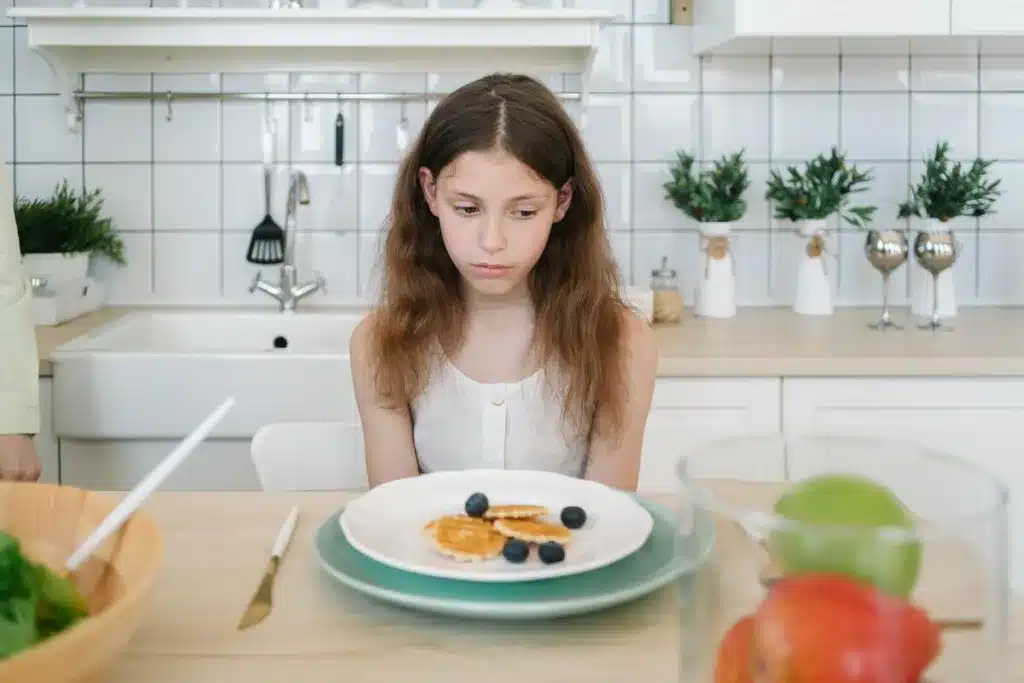Do your children turn up their noses at everything on the plate? You’re not alone! Many parents and caregivers face the challenges brought by a child refusing to eat, especially when trying to introduce healthy foods. In this article, we’ll share three proven strategies to turn food refusal into food fun, helping your child explore new flavors and nourishing their body one bite at a time!
Understanding Mealtime Refusals
If you’re wondering how to get a child to eat when they refuse, the quick answer is rather simple: Don’t give up! Unfortunately, the path from theory to practice it’s more complex than that. Refusals can make parents anxious, especially when their children’s unhealthy relationship with food impacts their development. Worries can extend to nutritional deficiencies, weight issues, or the establishment of lifelong poor eating habits. Parents may also feel a sense of failure or guilt, questioning their abilities to nourish their young kids properly.
A picky eater’s tantrums can affect the rest of the family too. Investing time and energy to coax one member to eat can unintentionally lead to others feeling neglected or overshadowed. Mealtimes can become stressful events rather than enjoyable family gatherings.
The underlying factors for young children’s food refusals can be varied. It might be about the sensory impact of certain types of food, like how they look, smell, or feel. Sometimes it’s related to health issues, such as teething or constipation. Understanding and identifying these individual factors can be vital for improving children’s relationship with food.
What Causes a Child to Refuse Food?

Credit: Photo by CottonBro Studio on Pexels
This is not an easy riddle. It’s not always simple to figure this out. There are many reasons why a child refuses to eat. It could be physical discomfort, memories of past bad experiences, feeling pushed, a hectic mealtime routine, or even just copying what they see in their parents, siblings, or peers.
Factors contributing to picky eating behavior
Physical Discomfort: Sometimes, a child refuses to eat because something physical is bothering them. Maybe they’re teething, and their gums hurt. If they’re constipated, they might link eating to that discomfort. Food allergies can also make eating an unpleasant experience. If parents suspect that medical issues might be the underlying cause of a child’s refusal to eat, they can seek guidance from a pediatric specialist. These professionals can perform a thorough examination to rule out or diagnose any underlying medical conditions.
Past Experience with Certain Foods: A child’s previous experiences with food can shape their current eating behavior. Negative experiences such as choking, vomiting, or being forced to eat certain foods can create lasting fears or aversions for them. Foods that look, smell, taste, or have the same texture as the ones rejected might also trigger refusals.
Harsh Persuading Methods: The methods used to persuade a child to eat can have unintended consequences. When trying to become creative with how to get a child to eat when they refuse, keep in mind that insisting, bribing, or punishing a child for not eating may create power struggles and increase resistance. Children might feel pressured and overwhelmed, leading them to refuse food even more. Additionally, feeding becomes a chore, not an act of keeping a healthy body and mind, impacting habits even in adulthood.
A lack of routine around meals: This can create confusion and reluctance to eat. If the schedule is inconsistent, children may not develop regular hunger cues. They might not be hungry when food is offered, or they might fill up on snacks between meals. If families are constantly eating in a rush or while distracted, children may not learn to associate mealtime with relaxation and enjoyment.
External influence: Attitudes and behaviors of parents, siblings, or peers around food can greatly influence a child’s eating habits. If close family members or friends have a negative attitude toward cooking, are preoccupied with dieting, or show a lack of interest in certain foods, children may mimic these behaviors. For example, if siblings or peers make fun of certain foods or refuse to eat them, a child may follow suit, fearing ridicule or exclusion.
While all these factors play their part to some extent, the most common reasons to look for when a child refusing to eat becomes a habit are a child’s unhealthy food choices and the presence of distractions.

Credit: Freepik
If kids eat too many processed or sugary foods, like candy, soda, fast food or pre-cooked meals, they might not want to try healthier foods. They will find fruits and vegetables strange or unappealing.
Studies tell us that most people in the United States aren’t getting enough micronutrients – the vitamins and minerals vital to healthy development, disease prevention, and well-being. This is because junk food is packed with calories but doesn’t have much nutritional value. When kids eat fast food, their brains respond quickly. It’s usually the salty, sweet, or fatty taste that triggers the reward system in our brain. This is why we might crave it.
Whole foods, on the other hand, like fresh fruits, veggies, and whole grains, have a unique texture and usually a milder taste. They don’t deliver the same immediate punch to our taste buds, even though they come loaded with vitamins, minerals, fibre and other essential nutrients. The difference between eating whole foods or highly processed ones is the difference between feeding your body or just filling it.
👉 Read more about strong-willed children and how to make them cooperate in our article on ‘How to Get a Strong-Willed Child to Listen.’ Read it to discover effective strategies!
Overpowering distractions during mealtime
Many parents have noticed that some kids seem to eat better when they are watching videos on a device or playing with toys and books during meals. Some healthcare professionals even advise parents to use this approach if their kids have serious feeding problems, like only eating certain foods or when refusals result in dramatic weight loss. In some cases, getting food inside a child becomes so desperate that it requires drastic measures.

Credit: Freepik
Fortunately, these situations are not common for a typically developing child. Kids will pick up on what’s the default in their environments. If the adults and other family members have a healthy relationship with food, children are likely to develop similar healthy habits.
Using distractions might seem like a handy trick to get a 2-year-old to eat, but it can lead to some problems down the road. When we teach our kids to sit still at the table using hand puppets or playing cartoons on a device, we make them associate mealtime with those actions.
This becomes a hard habit to break. The pleasure of the game or the show can become more important than the experience of eating. They’ll be focused on what’s playing on the screen, not on what’s on their plate. This might be cute when they’re eating purees, but tricks like wriggling Mr. Hungry Dinosaur or playing a few episodes of Peppa Pig won’t work as they get older. On top of that, this easy fix won’t allow you to think of healthier solutions on how to get a child to eat when they refuse. Additionally, this approach can make children more attached to screens. If they don’t already crave screen time, giving them a device during dinner can get them closer to forming that attachment.
The Impact of Picky Eating on Child’s Health and Nutrition
Picky eating can have real consequences on a child’s well-being. Whether it’s refusing essential food groups or leaning towards unhealthy food choices, these habits can lead to physical, emotional, or behavioral issues. When a child refuses to eat on a regular basis, you should be worried and do something about that.

Credit: Picture by Mikhail Nilov on Pexels
- Weakened Immune System: Optimal nutrition is essential in childhood. This is a crucial period for the development of the immune system, which helps the body fight off infections. Poor nutrition at this stage can make your little one more susceptible to illness or take longer to recover from it. When the body is not getting the nutrients it needs, respiratory infections such as colds and flu can be recurrent and frequent, and even minor wounds may take longer to heal.
- Lack of energy: Feeling tired all the time, weaker, and having low energy levels are often signs of nutritional deficiencies. For example, a lack of iron can lead to anemia, resulting in constant fatigue and an inability to keep up with peers in physical activities.
- Poor concentration and behavioral changes: Children who do not get enough nutritious food might suffer from poor concentration and changes in behavior, such as being unusually irritable, slow, or anxious. These symptoms can affect school performance and social interactions.
How to get a child to eat when they refuse: 3 Proven Strategies to Convince a Fussy Eater to Eat
How to get a child to eat when they refuse? That might be a challenge, but there are some proven strategies that can help when a child refuses to eat. The following methods will show you how to avoid power struggles and keep dinner time happy and relaxed. At the same time, you will learn how to cultivate healthy eating habits in your child. It’s okay if they don’t like certain foods; working together, you can find alternatives.
Whether they’re just starting with solid foods or picky eating is already a steady battle in your routine, these strategies are proven to improve family dynamics during mealtime. By adopting a cooperative approach and infusing mealtime with fun and understanding, you’re fostering a positive relationship with food. They may not eat sweet potatoes and spinach at the next meal, but embracing patience, focusing on enjoyable experiences, and maintaining open communication can make food more appealing.
1. Create a Positive Mealtime Environment

Credit: Photo by Vanessa Loring on Pexels
Since people first started living together in communities, sharing meals has always been about more than just eating. It’s a way for people to come together and connect. Whether it’s a big celebration or a simple family dinner, food has a special way of bringing people closer. Here are a few ways to create a positive environment:
Family Traditions: Some families have special ways of preparing for meals, like setting the table together, always sitting in the same seats, or sharing highlights of the day before eating.
Regular Meal Times: Eating at the same times every day helps kids know what to expect. It makes mealtime a regular part of the day and helps everyone feel more organized.
Modeling Behavior: When children see parents and siblings enjoying a variety of foods, they often become curious. If the adults around them are enjoying something, they might want to try it too.
Something for Everyone: Making sure there’s something on the table that everyone likes shows that everyone’s tastes are important. It makes kids feel included and cared for. While the approach “they’ll eat when they’re hungry” might seem logical, it doesn’t always work with picky eaters.
Patience with Temporary Phases: Many children go through phases where they are selective about food. Understanding that it might just be a temporary phase can help parents stay calm and consistent in their approach.
Pressure Doesn’t Help: Forcing or pressuring a child to eat something they don’t want might create a negative association with that food. It can make mealtime stressful and turn trying new foods into a battle.
2. Introduce New Foods in a Fun Way
Making meals fun and engaging can often do the trick. The key is to make trying new foods an enjoyable adventure rather than a chore. Setting attractive plates, arranging food into fun shapes, or even making up stories about the food can spark a picky 5 year-old’s interest. Here are a few ideas:

Credit: Freepik
Cooking sessions: Sometimes, being involved in the cooking process can spark curiosity in children. Washing vegetables or stirring a pot can be fun, making them feel proud of what they’ve made and more willing to try it. Cooking homemade versions of their favorite food could be a great starting point. Children can assemble their own tacos or make their own mini pizzas. This allows them to have control over the menu and have fun with their food.
Character-Themed Foods: How to get a child to eat when they refuse? Turning foods into characters like Mr. Carrot, The Sweet Potato King, or The Almighty Pea Brothers can make children more interested in trying them.
Colorful Plates: Using colorful plates or arranging food in fun shapes, like a rainbow made with peanut butter and fruit, can make the meal visually appealing.
Food Art: Letting kids create art with their food, such as making a face with different fruits or building a tree with broccoli and carrots, encourages sensory exploration.
Garden to Table: If possible, growing some vegetables or herbs together and then using them in meals can be an educational and satisfying experience.
Musical Meals: When a child refuses to eat, playing soft background music that matches the theme of the meal can add a special touch and elevate the dining experience.
3. Overcome Mealtime Battles with Communication
Keep Conversation Positive: Talking negatively about food or eating habits at the dinner table can make mealtime stressful. Keeping things positive helps kids feel good about eating and trying different foods.
Allow choices: Instead of telling them to try a bit of everything or finish their plates, giving children some choices can make them feel in control. Letting them choose between two vegetables, for example, can make them more willing to eat one.
Take Food-Talks Outside the Kitchen: Conversations about food don’t have to be confined to the dining table or kitchen. Integrating food talks into playtime or bedtime routines can make learning about nutrition fun. Find or create storybooks that feature characters exploring different foods, like “The Adventures of the Fruit Family” or “Healthy Mr. Pumpkin.” Use toys or drawings to illustrate where food comes from and how it keeps us healthy.
Ask other family members to pitch in: Involving other family members can make the food experience more enriching and take off some pressure from parents. Grandparents can share traditional recipes or food-related family stories, while older siblings can assist in food preparation, making it a team effort.
Celebrating Success: Praising children for trying, even if it’s just a small taste, can build their confidence. Celebrating the effort rather than the amount eaten encourages them to keep trying new things.
Dealing with Persistent Picky Eating
Picky eating might seem like a typical kid thing, but if we’re not careful, it can stick around longer than we’d like. A study that followed kids and their eating habits over a three-year span was recently published.
The big takeaway? While a bunch of kids grow out of that “I only eat noodles” phase as they age, some double down on their food fussiness. These hardcore picky eaters aren’t just pushing peas around on their plates; they’re in a league of their own.
It’s not just about rejecting specific dishes; these children might consistently eat less than they should, skipping out on valuable nutrition. They may also be reluctant to try new dishes, sticking to their familiar comfort foods.
In essence, while some level of food fussiness can be expected in children, for some, it’s more than just a phase. It underscores the importance of monitoring eating habits from early on and being proactive in introducing a varied diet, ensuring that mealtime doesn’t become a recurring battleground.
When to Seek Professional Help
Children’s eating behaviors can sometimes reflect deeper health concerns. Parents and caregivers should be attentive to the signs that may indicate a need for professional help. Pediatricians, nutritionists, therapists, and other healthcare experts play a crucial role in diagnosing, managing, and treating the underlying issues, whether it’s an allergy, eating disorder, developmental concern, or growth-related issue.
Timely intervention can make a significant difference in a child’s well-being, development, and quality of life. Here’s a breakdown of the specific scenarios when professional help may be needed when a child refuses to eat periodically:
Extreme weight loss or stunted growth: When a child is not growing as expected or exhibits unusual weight loss, it could be a sign of a more serious underlying health problem. This is particularly concerning if the child is a picky eater, as this can lead to significant nutritional deficiencies. In such cases, the immediate attention of healthcare professionals is crucial. Pediatricians can perform a comprehensive examination to determine the root cause of the growth issue, while nutritionists can work to create a specialized diet that ensures the child’s nutritional needs are met.
Allergies: Food allergies are an increasingly common issue in children. If your child experiences symptoms like hives, difficulty breathing, or digestive issues after eating certain foods, it’s vital to consult a healthcare professional. A pediatrician or allergist can perform tests to identify the specific allergens, and a dietitian can help create a balanced diet that avoids these triggers while still meeting nutritional needs.
Eating disorders: Eating disorders can begin to manifest in childhood or adolescence, and early intervention is critical. Signs may include an obsession with weight, extreme dieting, child refusing to eat, binge eating, or purging. Professional counseling, along with medical and nutritional support, is typically required to address these complex, serious issues. Therapists specializing in eating disorders can provide essential treatment and support for the child and family.
Pointing to autism spectrum disorders: Children on the autism spectrum may exhibit specific eating behaviors, such as extreme pickiness, sensitivity to textures, or a fixation on certain foods. If these behaviors are persistent and interfere with daily life, it could indicate a need for assessment by a professional specializing in autism. An early diagnosis can lead to more effective interventions, including personalized mealtime strategies developed by a therapist or nutritionist.
👉 Wondering if your child is spoiled and how overindulgent parenting can impact their life? Explore the signs and consequences in this article.
Conclusion
You might now have a better idea of how to get a child to eat when they refuse. By being consistent, creating a positive and encouraging atmosphere, and offering choices, you can support your children in expanding their palates. Involving them in preparation, being patient, and celebrating successes along the way makes the journey easier. Another thing is to recognize that this might just be a phase – sometimes, a child refuses to eat for a short period of time, and then things get back to normal.
The key is to build a positive association with food and dinner time, turning it into an opportunity for creativity, bonding, and discovery. When integrating some of these practices into family meals, you can make eating enjoyable and also instill a love for diverse and nutritious foods.
Join us at the parenting event: “5 Steps to Get What You Want from Your Child Without Getting Angry or Giving In!” Struggling with how to get a child to eat when they refuse or getting into power struggles when asking them to complete their chores? We’ve got you covered. Dive into expert-led strategies tailored for these challenges and more. Transform those “no’s” into nods of agreement and build stronger bonds with your child. Don’t miss out on these invaluable insights – because parenting is easier when you’re equipped with the right tools! If your child refuses to eat, you have to register today!
Have a burning question about your everyday parenting? Our clever AI assistant, Sophie is ready to share some science-based strategies to address any concern you might have.
References
Allen, R.E., & Myers, A.L. (2006). Nutrition in toddlers. American Family Physician, 74(9), 1527-32. PMID: 17111891.
Bellisle, F. (2004). Effects of diet on behavior and cognition in children. British Journal of Nutrition, 92(S2), 227-232. https://doi.org/10.1079/BJN20041171
Cano, S. C., Tiemeier, H., Hoeken, D. V., Tharner, A., Jaddoe, W. V., Hofman, A., Verhulst, F. C., & Hoek, H. W. (2015). Trajectories of picky eating during childhood: A general population study. International Journal of Eating Disorders, 48(6), 570-579. https://doi.org/10.1002/eat.22384
Chao, H. (2018). Association of Picky Eating with Growth, Nutritional Status, Development, Physical Activity, and Health in Preschool Children. Frontiers in Pediatrics, 6, 316396. https://doi.org/10.3389/fped.2018.00022
Diamantis, D. V., Emmett, P. M., & Taylor, C. M. (2023). Effect of being a persistent picky eater on feeding difficulties in school-aged children. Appetite, 183, 106483. https://doi.org/10.1016/j.appet.2023.106483
Liguori, C. A., Nikolaus, C. J., & Nickols-Richardson, S. M. (2020). Cognitive Distraction at Mealtime Decreases Amount Consumed in Healthy Young Adults: A Randomized Crossover Exploratory Study. The Journal of Nutrition, 150(5), 1324-1329. https://doi.org/10.1093/jn/nxaa022
Pai, U. A., Chandrasekhar, P., Carvalho, R. S., & Kumar, S. (2018). The role of nutrition in immunity in infants and toddlers: An expert panel opinion. Clinical Epidemiology and Global Health, 6(4), 155-159. https://doi.org/10.1016/j.cegh.2017.11.004
Palos Lucio, A. G., Sansores Martínez, D. N., Olvera Miranda, C., & Quezada Méndez, L. (2020). Nutritional Quality of Fast Food Kids Meals and Their Contribution to the Diets of School-Aged Children. Nutrients, 12(3), 612. https://doi.org/10.3390/nu12030612
Scaglioni, S., Cosmi, V. D., Ciappolino, V., Parazzini, F., Brambilla, P., & Agostoni, C. (2018). Factors Influencing Children’s Eating Behaviours. Nutrients, 10(6). https://doi.org/10.3390/nu10060706
Steinsbekk, S., Bonneville-Roussy, A., Fildes, A., Llewellyn, C. H., & Wichstrøm, L. (2017). Child and parent predictors of picky eating from preschool to school age. The International Journal of Behavioral Nutrition and Physical Activity, 14. https://doi.org/10.1186/s12966-017-0542-7
Taylor, C. M., & Emmett, P. M. (2018). Picky eating in children: Causes and consequences. The Proceedings of the Nutrition Society, 1. https://doi.org/10.1017/S0029665118002586
Taylor, C. M., Wernimont, S. M., Northstone, K., & Emmett, P. M. (2015). Picky/fussy eating in children: Review of definitions, assessment, prevalence and dietary intakes. Appetite, 95, 349-359. https://doi.org/10.1016/j.appet.2015.07.026
Ziauddeen, N., Page, P., Penney, T. L., Nicholson, S., Kirk, S. F., & Almiron-Roig, E. (2018). Eating at food outlets and leisure places and “on the go” is associated with less-healthy food choices than eating at home and in school in children: Cross-sectional data from the UK National Diet and Nutrition Survey Rolling Program (2008–2014). The American Journal of Clinical Nutrition, 107(6), 992-1003. https://doi.org/10.1093/ajcn/nqy057
Zucker, N. L., & Hughes, S. O. (2020). The Persistence of Picky Eating: Opportunities to Improve Our Strategies and Messaging. Pediatrics, 145(6). https://doi.org/10.1542/peds.2020-0893









